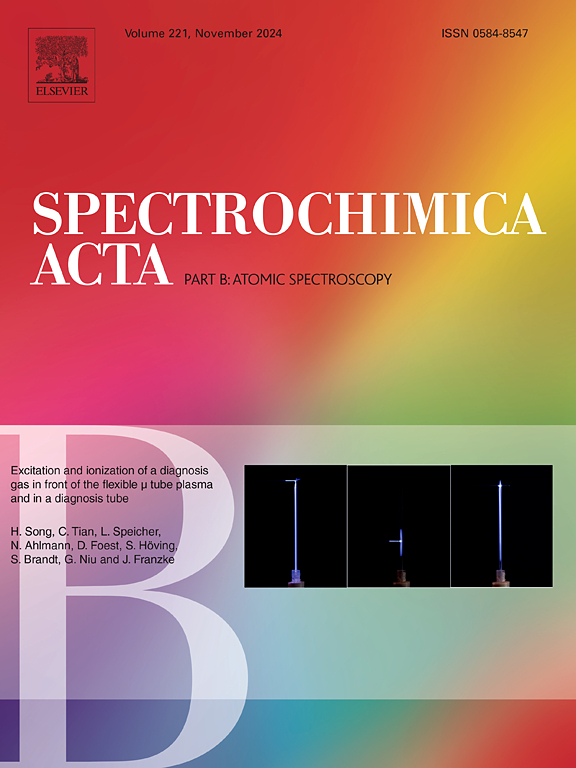用h - α线多普勒光谱研究含氢气体混合物中低压脉冲放电产生的快氢原子
IF 3.8
2区 化学
Q1 SPECTROSCOPY
引用次数: 0
摘要
Hα谱线的多普勒光谱用于研究在低压下工作的新型气体放电源在含氢气体混合物中产生的快氢原子。在脉冲高压状态下,在杆状阴极周围形成放电,可以改变脉冲宽度、占空比和电参数。阴极材料有铜、不锈钢、铝和石墨。在氩载气条件下,应用由两个高斯分布组成的拟合函数,分析了相对于表面法线90°的侧边Hα分布,以测量平均动能、最大获得能量和快激发原子对总H I分布的贡献。H - I线的基座反映了放电中快速H*原子的存在。从端面上的H*能量剖面(沿表面法线观察)推导出最大H*能量,并与侧面结果进行了比较。快速H*的径向分布描述了阴极表面附近平均动能的线性下降,以及组分面积过宽与气体压力的强烈依赖性。在H2, H2 + 5% Ar和Ne+ 0.8% H2的情况下,整体拟合包括三个高斯分量。石墨阴极的平均动能分别为37 eV (Ar + 3% H2)、102 eV (H2 + 5% Ar)、76 eV (N2 + 5% H2)、167 eV (Ne+ 0.8% H2)和180 eV (H2)。石墨阴极的快氢原子(最大电压不超过750 V)能量最低,主要是由于能量反射系数值低。铜阴极和氖氢混合物在鞘层中获得的最大能量(~ 425 eV)。本文章由计算机程序翻译,如有差异,请以英文原文为准。

The investigation of fast hydrogen atoms created in low pressure pulsed discharge in hydrogen-containing gas mixtures by means of Hα line Doppler spectroscopy
Doppler spectroscopy of the Hα line is used for the study of fast hydrogen atoms created in a novel gas discharge source operating at lower pressure in hydrogen-containing gas mixtures. The discharge is formed around the rod shaped cathode in pulsed high voltage regime with the possibility to change pulse width, duty cycle and electric parameters. The cathodes made of copper, stainless steel, aluminum and graphite are used in the frame of this study. In case of argon carrier gas, the fitting function consisting of two Gaussian profiles is applied and the side-on Hα profiles (observation angle 90° relative to the surface normal) are analyzed in order to measure mean kinetic energy, maximum gained energy and the contribution of fast excited atoms to overall H I profile. The pedestal of the H I line reflects the presence of fast H* atoms in the discharge. From the end-on H I profiles (observation along the surface normal), the maximum H* energy is deduced and compared with the side-on results. The radial distribution of fast H* depicted the linear decrease of mean kinetic energy near the cathode surface as well as the strong dependence of excessive broad component area with gas pressure. In case of H2, H2 + 5 % Ar and Ne+0.8 % H2, the overall fit comprises three Gaussian components. In case of graphite cathode, the mean kinetic energies are 37 eV (Ar + 3 % H2), 102 eV (H2 + 5 % Ar), 76 eV (N2 + 5 % H2), 167 (Ne+0.8 % H2) and 180 eV (H2). The energy of fast H* atoms with the graphite cathode (the maximum voltage not exceeding 750 V) has the lowest value mainly due to low values of energy reflection coefficients. The maximum energy gained in the sheath (∼425 eV) is achieved for the copper cathode and neon‑hydrogen mixture.
求助全文
通过发布文献求助,成功后即可免费获取论文全文。
去求助
来源期刊
CiteScore
6.10
自引率
12.10%
发文量
173
审稿时长
81 days
期刊介绍:
Spectrochimica Acta Part B: Atomic Spectroscopy, is intended for the rapid publication of both original work and reviews in the following fields:
Atomic Emission (AES), Atomic Absorption (AAS) and Atomic Fluorescence (AFS) spectroscopy;
Mass Spectrometry (MS) for inorganic analysis covering Spark Source (SS-MS), Inductively Coupled Plasma (ICP-MS), Glow Discharge (GD-MS), and Secondary Ion Mass Spectrometry (SIMS).
Laser induced atomic spectroscopy for inorganic analysis, including non-linear optical laser spectroscopy, covering Laser Enhanced Ionization (LEI), Laser Induced Fluorescence (LIF), Resonance Ionization Spectroscopy (RIS) and Resonance Ionization Mass Spectrometry (RIMS); Laser Induced Breakdown Spectroscopy (LIBS); Cavity Ringdown Spectroscopy (CRDS), Laser Ablation Inductively Coupled Plasma Atomic Emission Spectroscopy (LA-ICP-AES) and Laser Ablation Inductively Coupled Plasma Mass Spectrometry (LA-ICP-MS).
X-ray spectrometry, X-ray Optics and Microanalysis, including X-ray fluorescence spectrometry (XRF) and related techniques, in particular Total-reflection X-ray Fluorescence Spectrometry (TXRF), and Synchrotron Radiation-excited Total reflection XRF (SR-TXRF).
Manuscripts dealing with (i) fundamentals, (ii) methodology development, (iii)instrumentation, and (iv) applications, can be submitted for publication.

 求助内容:
求助内容: 应助结果提醒方式:
应助结果提醒方式:


